
The Archdiocese of New York is an ecclesiastical territory or archdiocese of the Catholic Church located in the State of New York. It encompasses the boroughs of Manhattan, the Bronx and Staten Island in New York City and the counties of Dutchess, Orange, Putnam, Rockland, Sullivan, Ulster, and Westchester. The Archdiocese of New York is the second-largest diocese in the United States by population, encompassing 296 parishes that serve around 2.8 million Catholics, in addition to hundreds of Catholic schools, hospitals and charities. The archdiocese also operates the well-known St. Joseph's Seminary, commonly referred to as Dunwoodie. The Archdiocese of New York is the metropolitan see of the ecclesiastical province of New York which includes the suffragan dioceses of Albany, Brooklyn, Buffalo, Ogdensburg, Rochester, Rockville Centre and Syracuse.

Mount Holly Cemetery is a historic cemetery located in the Quapaw Quarter area of downtown Little Rock in the U.S. state of Arkansas, and is the burial place for numerous Arkansans of note. It was listed on the National Register of Historic Places in 1970 and has been nicknamed "The Westminster Abbey of Arkansas".

Thomas James Churchill was an American politician who served as the 13th governor of Arkansas from 1881 to 1883. Before that, he was a senior officer of the Confederate States Army who commanded infantry in the Western and Trans-Mississippi theaters of the American Civil War.

Augustus Hill Garland was an American lawyer and Democratic politician from Arkansas, who initially opposed Arkansas' secession from the United States, but later served in both houses of the Congress of the Confederate States and the United States Senate, as well as becoming the 11th governor of Arkansas (1874–1877) and the 38th attorney general of the United States (1885–1889).

The Metropolitan Archdiocese of Baltimore is the premier see of the Latin Church of the Catholic Church in the United States. The archdiocese comprises the City of Baltimore and nine of Maryland's 23 counties in the central and western portions of the state: Allegany – Anne Arundel – Baltimore – Carroll, Frederick, Garrett–Harford, Howard, and Washington. The archdiocese is the metropolitan see of the larger regional Ecclesiastical Province of Baltimore. The Archdiocese of Washington was originally part of the Archdiocese of Baltimore.
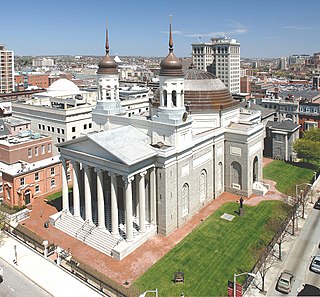
The Basilica of the National Shrine of the Assumption of the Blessed Virgin Mary, also called the Baltimore Basilica, was the first Roman Catholic cathedral built in the United States, and was among the first major religious buildings constructed in the nation after the adoption of the U.S. Constitution. As a co-cathedral, it is one of the seats of the Catholic Archdiocese in Baltimore, Maryland. Additionally it is a parish church and national shrine. It is considered the masterpiece of Benjamin Henry Latrobe, the "Father of American Architecture".

Hollywood Cemetery is a large, sprawling cemetery located next to Richmond, Virginia's, Oregon Hill neighborhood at 412 South Cherry Street. Characterized by rolling hills and winding paths overlooking the James River, it is the resting place of two United States Presidents, James Monroe and John Tyler, as well as the only Confederate States President, Jefferson Davis. It is also the resting place of 28 Confederate generals, more than any other cemetery in the country; these include George Pickett and J.E.B. Stuart.

The 2nd Confederate States Congress, consisting of the Confederate States Senate and the Confederate States House of Representatives, met from May 2, 1864, to March 18, 1865, during the last year of Jefferson Davis's presidency, at the Virginia State Capitol in Richmond, Virginia; the Confederacy's government effectively dissolved 16 days later, when it fled Richmond on April 3, 1865. Its members were elected in the 1863 congressional elections.
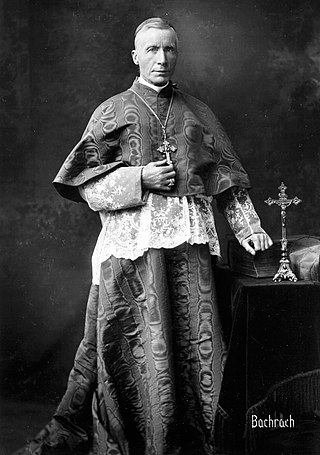
James Cardinal Gibbons was a senior-ranking American prelate of the Catholic Church who served as apostolic vicar of the Apostolic Vicariate of North Carolina from 1868 to 1872, bishop of the Diocese of Richmond in Virginia from 1872 to 1877, and as ninth archbishop of the Archdiocese of Baltimore in Maryland from 1877 until his death. He was elevated to the rank of cardinal in 1886.
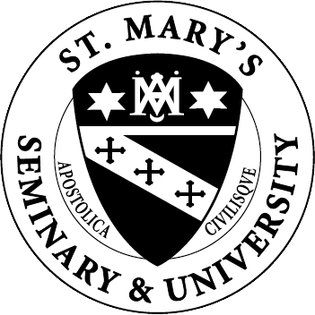
St. Mary's Seminary and University is a Catholic seminary located within the Archdiocese of Baltimore in Baltimore, Maryland; it was the first seminary founded in the United States after the Revolution and has been run since its founding by the Society of the Priests of Saint Sulpice.
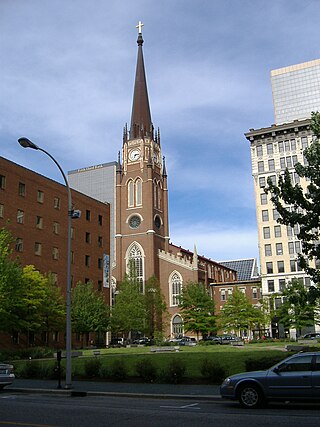
The Archdiocese of Louisville is a Latin Church ecclesiastical territory, or archdiocese, of the Catholic Church in central Kentucky in the United States. The cathedral church of the archdiocese is the Cathedral of the Assumption in Louisville.

Lexington Cemetery is a private, non-profit 170-acre (69 ha) rural cemetery and arboretum located at 833 W. Main Street, Lexington, Kentucky.

The Cathedral Basilica of Saints Peter and Paul, head church of the Roman Catholic Archdiocese of Philadelphia, is located at 18th Street and the Benjamin Franklin Parkway, on the east side of Logan Square in Philadelphia. It was built between 1846 and 1864, and was designed by Napoleon LeBrun, from original plans by the Reverend Mariano Muller and the Reverend John B. Tornatore, with the dome and Palladian facade, designed by John Notman, added after 1850. The interior was largely decorated by Constantino Brumidi.

Martin John Spalding was an American prelate of the Roman Catholic Church. He served as Bishop of Louisville (1850–1864) and Archbishop of Baltimore (1864–1872). He advocated aid for freed slaves following the American Civil War. Spalding attended the First Vatican Council, where he first opposed, and then supported, a dogmatic proclamation of papal infallibility.
William Byrne was an Irish-born American Roman Catholic missionary and educator. He was born in County Wicklow, Ireland and died at Bardstown, Kentucky.
This is an incomplete list of historic properties and districts at United States colleges and universities that are listed on the National Register of Historic Places (NRHP). This includes National Historic Landmarks (NHLs) and other National Register of Historic Places listings. It includes listings at current and former educational institutions.
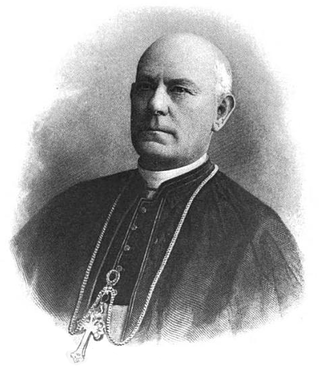
John Lancaster Spalding was an American author, poet, advocate for higher education, the first bishop of the Roman Catholic Diocese of Peoria from 1877 to 1908 and a co-founder of The Catholic University of America.

Academy of Our Lady and Spalding Institute were Catholic high schools across the street from each other in downtown Peoria, Illinois.
The University of Notre Dame's annual commencement exercises are held each May, currently in the Notre Dame Stadium. The exercises award undergraduate and graduate degrees.
The history of the Irish in Baltimore dates back to the early and mid-19th century. The city's Irish-American community is centered in the neighborhoods of Hampden, Canton, Highlandtown, Fell's Point and Locust Point.

















